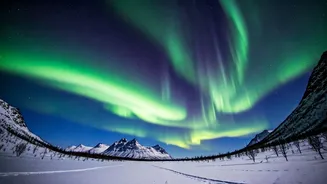What are Auroras?
Auroras, often referred to as the Northern Lights (aurora borealis) and Southern Lights (aurora australis), are spectacular displays of light in the sky.
These shimmering curtains of light are produced when electrically charged particles from the sun collide with gases in the Earth's atmosphere. These collisions cause the gases to emit light of varying colors, most commonly green, but also red, blue, and purple. The intensity and visibility of auroras are closely linked to solar activity, with coronal mass ejections and solar flares playing a significant role. The intensity of these light displays vary. They can be very faint, and difficult to see with the naked eye. In other cases, when the solar activity is significant, the display can be very bright.
Solar Activity's Role
The sun's activity is the primary driver of aurora displays. Solar flares and coronal mass ejections (CMEs) send vast amounts of charged particles, known as solar wind, towards Earth. When these particles encounter Earth's magnetic field, they are channeled towards the polar regions. Upon entering the upper atmosphere, these particles collide with atmospheric gases such as oxygen and nitrogen. These collisions excite the gas molecules, which then emit light at different wavelengths, resulting in the diverse colors seen in auroras. The frequency and intensity of auroras increase during periods of high solar activity, which follows an approximately 11-year cycle. Understanding solar activity is, therefore, crucial for predicting and experiencing auroras.
Forecasting Auroras
Predicting aurora activity involves monitoring various factors. Space weather agencies provide forecasts and alerts based on observations of solar activity, the solar wind, and Earth's magnetic field. Geomagnetic storm warnings are also issued, which indicate the likelihood of auroras. These forecasts offer insights into when and where the Northern Lights might be visible. While forecasting is helpful, it is important to remember that it is still an inexact science, and forecasts can change. Aurora forecasts may provide estimates of the intensity of aurora displays, as well as the geographical regions where they are most likely to be visible. Websites and apps dedicated to aurora viewing, provide real-time updates and alerts that are invaluable to those who want to see them.
Where to Observe
The ideal locations for viewing the Northern Lights are in regions with minimal light pollution and clear skies. While the auroras are most frequently observed in the high-latitude regions, such as the Arctic Circle, they can sometimes be visible in lower latitudes during periods of intense solar activity. For viewers in India, direct observation within the country is highly improbable. However, with appropriate aurora alerts and forecasts, it may be possible for travelers to plan a trip to see them. Some potential viewing areas can include regions in North America or Europe. It's essential to plan a trip around the aurora forecast and find a location with a low level of light pollution.
Tips for Viewing
To maximize your chances of seeing the Northern Lights, it is important to choose a viewing location away from city lights and other light sources. Dark, rural areas offer the best views. Check aurora forecasts and weather conditions before heading out. The auroras may appear in various colors, with green being the most common, but also red, blue, and purple. Patience is key, as the displays can be fleeting. Allow your eyes to adjust to the darkness for at least 20-30 minutes, as this will improve your ability to see the auroras. If possible, consider using a camera with a long exposure setting to capture images of the aurora, and bring warm clothing because it may get cold when waiting for an aurora.
Recent Sightings & Alerts
Over the past few months, there have been several alerts and sightings of the Northern Lights. Reports indicate that the Northern Lights may have been visible in various locations in the United States and Europe. Forecasts have been issued on multiple occasions, warning of the possibility of impressive aurora displays, particularly during periods of intense solar activity, such as after solar flares and coronal mass ejections. Aurora alerts also come from the Met Office, which provides forecasts for the Northern Hemisphere. It's advisable to stay updated with these alerts to stay informed about potential viewing opportunities.















